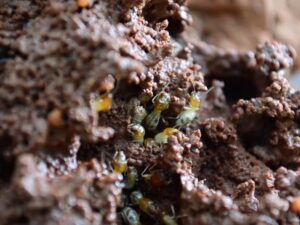Termite Control & Protection in and around Quincy, IL

Termites are a serious threat to homes in the Quincy, IL area. These silent destroyers can cause extensive, costly damage before you even know they’re present. At Double G Pest Control, we specialize in comprehensive termite inspections, treatments, and preventative solutions. We understand the local termite species and use the most effective methods to protect your property.
The Silent Threat: Understanding Termites in Quincy, IL
In our region, termites are the most common and destructive type. These termites live in underground colonies and build mud tubes to access wood in your home. They feed on cellulose, the main component of wood, and can silently weaken the structural integrity of your house, leading to significant repairs.
It is also important to know that Subterranean Termites are not the only species that call Quincy their home. Formosan Termites are the most aggressive and can cause damage much more rapidly. While more common in southern states, it is imperative to be aware of their ability to infest Quincy homes.
Signs of a Termite Infestation: Don’t Wait Until It’s Too Late
 Early detection is crucial for minimizing termite damage. Here are some key signs to watch out for:
Early detection is crucial for minimizing termite damage. Here are some key signs to watch out for:
- Mud Tubes:These pencil-sized tubes are built by subterranean termites along foundation walls, crawl spaces, or other surfaces to provide a protected pathway between the soil and their food source (your home).
- Discarded Wings: Swarmers (winged reproductive termites) shed their wings after mating. Finding piles of these wings near windows, doors, or light fixtures is a strong indicator of a nearby colony.
- Hollow-Sounding Wood: As termites eat away at the wood from the inside, tapping on affected areas may produce a hollow or papery sound.
- Damaged Wood: Look for wood that appears blistered, warped, or has visible tunnels or galleries. This can be difficult to spot as damage often occurs behind walls.
- Stuck Windows or Doors: As termites damage the wood around windows and doors, the frames can warp, making them difficult to open or close.
- Frass (Termite Droppings): Drywood termites, less common in the Quincy area, leave behind small, wood-colored droppings (frass) near infested areas. Note Drywood termites for completeness, but emphasize Subterranean.
Our Termite Control Process: A Multi-Step Approach
Double G Pest Control offers a comprehensive termite control process designed for lasting protection:
- Thorough Inspection: Our licensed and experienced technicians will conduct a detailed inspection of your property, both inside and out, to identify signs of termite activity, assess the extent of the infestation (if any), and pinpoint vulnerable areas.
- Species Identification: We’ll accurately identify the type of termite infesting your home, as this informs the most effective treatment strategy.
- Customized Treatment Plan: Based on the inspection findings, we’ll develop a tailored treatment plan that may include:
- Liquid Termiticides: Applied to the soil around your foundation, creating a barrier that termites cannot cross.
- Baiting Systems: Strategically placed bait stations around your property attract termites, which then carry the bait back to the colony, ultimately eliminating it.
- Wood Treatment: Direct treatment of infested wood with termiticides, if necessary.
- Follow-Up Inspections: We’ll schedule follow-up inspections to monitor the effectiveness of the treatment and ensure the colony has been eliminated.
- Preventative Solutions: We’ll advise you on preventative measures to reduce the risk of future infestations, such as addressing moisture issues, removing wood-to-ground contact, and maintaining proper ventilation.
Why Choose Double G for Termite Control?
- Local Expertise: We have extensive experience dealing with termites specifically in Quincy.
- Advanced Technology: We use the latest, most effective termite control products and techniques.
- Licensed & Insured: Our technicians are fully licensed, insured, and highly trained.
- Guaranteed Results: We stand behind our services with a satisfaction guarantee. We’re committed to protecting your home.
- Transparent Pricing: We provide clear, upfront pricing with no hidden fees.
Protect Your Investment: Get a Free Termite Inspection
Don’t wait until termites cause significant damage to your home. Early detection and professional treatment are essential. Contact Double G Pest Control today for a free, no-obligation termite inspection. We’ll provide you with a detailed assessment and a customized plan to protect your most valuable investment.
Call us at 217-440-2847

